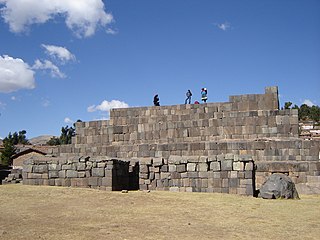
In Inca mythology, one of the main Inca creation myths was that of the Ayar Brothers who emerged from a cave called Paqariq Tampu.

Raqch'i (Quechua) is an Inca archaeological site in Peru located in the Cusco Region, Canchis Province, San Pedro District, near the populated place Raqch'i. It is 3480 meters above sea level and 110 kilometers from the city of Cuzco. It also known as the Temple of Wiracocha, one of its constituents. Both lie along the Vilcanota River. The site has experienced a recent increase in tourism in recent years, with 83,334 visitors to the site in 2006, up from 8,183 in 2000 and 452 in 1996.

Tambomachay is an archaeological site associated with the Inca Empire, located near Cusco, Peru. An alternate Spanish name is El Baño del Inca.

An ushnu or usnu is a pyramid-shaped, terraced structure that was used by the Inca to preside at the most important ceremonies of the Tawantinsuyu, or Inca Empire.
The Chilean Inca trail is a local and popular term among local tourism initiatives and Chilean anthropologists and archaeologists for the various branches of the Qhapak Ñan in Chile and its associated Inca archaeological sites.

Huamanmarca is an archaeological site in the region of Cusco, Peru. It is located in Huayopata District, La Convención Province, on the right bank of the Luq'umayu.

Inka Wasi or Inkawasi is an archaeological site in Peru. It is located in the Ayacucho Region, Parinacochas Province, Pullo District.

Inka Wasi is an archaeological site in the Huancavelica Region in Peru. The Inca palace is considered one of the most important monuments of the Huancavelica Region. Inka Wasi is located in the Huaytará Province, Huaytará District, about 25 km from Huaytará. It is situated at a height of 3,804 m (12,480 ft).

Tarmatambo or Tarmatampu is an archaeological site in the Junín Region in Peru. It is located in the Tarma Province, Tarma District, in the community of the same name. The site was declared a National Cultural Heritage by Resolución Directoral Nacional No. 040/INC on January 29, 2002.

Warawtampu is an archaeological site in the Pasco Region in Peru. It is located in the Daniel Alcides Carrión Province, Yanahuanca District, in the community of that name. The archaeological site of Astupampa is close to it.
Tupu Inka is an archaeological site in Peru. It is located in the Puno Region, Yunguyo Province, Unicachi District.
Inka Mach'ay is an archaeological site in Peru. It is situated in the Huancavelica Region, Tayacaja Province, Ñahuimpuquio District.
Inka Tampu or Inkatampu is an archaeological site in Peru. It is situated in the Cusco Region, La Convención Province, Huayopata District, at a height of about 2,127 metres (6,978 ft).
Inka Tampu or Inkatampu may refer to:

Ingatambo is an archaeological site in Peru. It is situated in the Cajamarca Region, Jaén Province, Pomahuaca District.
Cochapata or Qochapata is an archaeological site in Peru. It is located inthe district of Huayopata, La Convención Province, Cusco.
Tampu Mach'ay or Tampumach'ay is an archaeological site in Peru. It is located in the Huancavelica Region, Tayacaja Province, Acostambo District. Tampu Mach'ay is situated near the main square of Acostambo at a height of about 3,400 metres (11,155 ft).
Inkapintay or Inkapintayuq is an archaeological site in Peru with a rock painting. It is situated in the Cusco Region, Urubamba Province, Ollantaytambo District, near Ollantaytambo. The figure which draws the attention possibly depicts a noble person.

Tamboragra or Tambo Ragra is a 4,996-metre-high (16,391 ft) mountain in the Huaguruncho mountain range in the Andes of Peru. It is located in the Pasco Region, Pasco Province, on the border of the districts of Huachón and Ticlacayan. Tamboragra lies west of Añilcocha and northeast of Huaguruncho.












